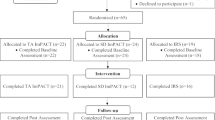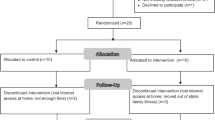Abstract
Conclusions about the efficacy of tele-therapy for parent-mediated intervention for children with Autism Spectrum Disorders (ASD) are limited, due to the shortage of direct comparisons between tele-therapy and traditional face-to-face therapy. In this study, we implemented a parent training program, which targeted on language facilitating intervention strategies. Fifteen parents of children with ASD participated in person, and 15 participated via online video conferencing. We measured parents’ intervention fidelity and children’s initiations, responses, lexical diversity and morphosyntactic complexity. Results indicated significant improvements in parents’ fidelity and children’s lexical diversity and morphosyntactic complexity. No significant differences were detected between the two therapy delivery groups on any outcome measures. Finally, children’s progress on morphosyntactic complexity was significantly correlated with parents’ improvement on fidelity.





Similar content being viewed by others
Notes
The first session does not refer to week 1 session and the last session does not refer to week 6 session. Recall that we had missing data, and some families were not able to attend sessions on week 1 or 6. Here, we included the very first session and very last session a family attended.
The two studies did not report frequency of initiations or responses per minute. They documented frequency in a session and the duration of a session. We calculated the maximum frequency using the data they provided.
References
American Psychiatric Association. (2013). Diagnostic and statistical manual of mental disorders (DSM-5®). Washington: American Psychiatric Publishing.
Ashburner, J., Vickerstaff, S., Beetge, J., & Copley, J. (2016). Remote versus face-to-face delivery of early intervention programs for children with autism spectrum disorders: Perceptions of rural families and service providers. Research in Autism Spectrum Disorders, 23, 1–14.
Baharav, E., & Reiser, C. (2010). Using telepractice in parent training in early autism. Telemedicine and e-Health, 16(6), 727–731.
Baio, J., Wiggins, L., Christensen, D. L., Maenner, M. J., Daniels, J., Warren, Z., et al. (2018). Prevalence of autism spectrum disorder among children aged 8 years—autism and developmental disabilities monitoring network, 11 sites, United States, 2014. MMWR Surveillance Summaries, 67(6), 1.
Barokova, M., & Tager-Flusberg, H. (2018). Commentary: Measuring language change through natural language samples. Journal of Autism and Developmental Disorders. https://doi.org/10.1007/s10803-018-3628-4.
Boisvert, M., & Hall, N. (2014). The use of telehealth in early autism training for parents: A scoping review. Smart Homecare Technology and TeleHealth, 2, 19–27.
Boisvert, M., Lang, R., Andrianopoulos, M., & Boscardin, M. L. (2010). Telepractice in the assessment and treatment of individuals with autism spectrum disorders: A systematic review. Developmental Neurorehabilitation, 13(6), 423–432.
Boucher, J. (2012). Research review: Structural language in autistic spectrum disorder–characteristics and causes. Journal of Child Psychology and Psychiatry, 53(3), 219–233.
Brown, R. (1973). A first language: The early stages. Cambridge, MA: Harvard University Press.
Casenhiser, D. M., Shanker, S. G., & Stieben, J. (2013). Learning through interaction in children with autism: Preliminary data from asocial-communication-based intervention. Autism, 17(2), 220–241.
Charman, T., Baron-Cohen, S., Swettenham, J., Baird, G., Drew, A., & Cox, A. (2003). Predicting language outcome in infants with autism and pervasive developmental disorder. International Journal of Language & Communication Disorders, 38(3), 265–285.
Deitchman, C., Reeve, S. A., Reeve, K. F., & Progar, P. R. (2010). Incorporating video feedback into self-management training to promote generalization of social initiations by children with autism. Education and Treatment of Children, 33(3), 475–488.
Drew, A., Baird, G., Taylor, E., Milne, E., & Charman, T. (2007). The Social Communication Assessment for Toddlers with Autism (SCATA): An instrument to measure the frequency, form and function of communication in toddlers with autism spectrum disorder. Journal of Autism and Developmental Disorders, 37(4), 648–666.
Eigsti, I. M., Bennetto, L., & Dadlani, M. B. (2007). Beyond pragmatics: Morphosyntactic development in autism. Journal of Autism and Developmental Disorders, 37(6), 1007–1023.
Fenson, L., Marchman, V. A., Thal, D., Dale, P. S., Reznick, J. S., & Bates, E. (2006). MacArthur-Bates communicative development inventories. Baltimore, MD: Brookes Publishing.
Gengoux, G. W., Berquist, K. L., Salzman, E., Schapp, S., Phillips, J. M., Frazier, T. W., et al. (2015). Pivotal response treatment parent training for autism: Findings from a 3-month follow-up evaluation. Journal of Autism and Developmental Disorders, 45(9), 2889–2898.
Geurts, H. M., & Embrechts, M. (2008). Language profiles in ASD, SLI, and ADHD. Journal of Autism Development Disorder, 38, 1931–1943.
Hao, Y., Sheng, L., Zhang, Y., Jiang, F., de Villiers, J., Lee, W., et al. (2018). A narrative evaluation of Mandarin-speaking children with language impairment. Journal of Speech, Language, and Hearing Research, 61(2), 345–359.
Huck, S. W. (2009). Statistical misconceptions. New York, NY: Taylor & Francis.
Hogan-Brown, A. L., Losh, M., Martin, G. E., & Mueffelmann, D. J. (2013). An investigation of narrative ability in boys with autism and fragile X syndrome. American Journal on Intellectual and Developmental Disabilities, 118(2), 77–94.
Hollingshead, A. A. (1975). Four-factor index of social status. New Haven, CT: Yale University.
Howlin, P., Goode, S., Hutton, J., & Rutter, M. (2004). Adult outcome for children with autism. Journal of Child Psychology and Psychiatry, 45, 212–229.
Huttenlocher, J., Vasilyeva, M., Cymerman, E., & Levine, S. (2002). Language input and child syntax. Cognitive Psychology, 45(3), 337–374.
Ingersoll, B., & Dvortscak, A. (2010). Teaching social communication to children with autism: A practitioner’s guide to parent training. New York: Guilford Press.
Ingersoll, B., Shannon, K., Berger, N., Pickard, K., & Holtz, B. (2017). Self-directed telehealth parent-mediated intervention for children with autism spectrum disorder: Examination of the potential reach and utilization in community settings. Journal of Medical Internet Research, 19(7), e248.
Ingersoll, B., & Wainer, A. (2013). Initial efficacy of Project ImPACT: A parent-mediated social communication intervention for young children with ASD. Journal of Autism and Developmental Disorders, 43(12), 2943–2952.
Ingersoll, B., Wainer, A. L., Berger, N. I., Pickard, K. E., & Bonter, N. (2016). Comparison of a self-directed and therapist-assisted telehealth parent-mediated intervention for children with ASD: A pilot RCT. Journal of Autism and Developmental Disorders, 46(7), 2275–2284.
Kasari, C., Paparella, T., Freeman, S., & Jahromi, L. B. (2008). Language outcome in autism: Randomized comparison of joint attention and play interventions. Journal of Consulting and Clinical Psychology, 76(1), 125–137.
Keen, D., Couzens, D., Muspratt, S., & Rodger, S. (2010). The effects of a parent-focused intervention for children with a recent diagnosis of autism spectrum disorder on parenting stress and competence. Research in Autism Spectrum Disorders, 4(2), 229–241.
Kobak, K. A., Stone, W. L., Wallace, E., Warren, Z., Swanson, A., & Robson, K. (2011). A web-based tutorial for parents of young children with autism: results from a pilot study. Telemedicine and E-health, 17(10), 804–808.
Leyfer, O. T., Tager-Flusberg, H., Dowd, M., Tomblin, J. B., & Folstein, S. E. (2008). Overlap between autism and specific language impairment: Comparison of autism diagnostic interview and autism diagnostic observation schedule scores. Autism Research, 1(5), 284–296.
Lindgren, S., Wacker, D., Suess, A., Schieltz, K., Pelzel, K., Kopelman, T., et al. (2016). Telehealth and autism: Treating challenging behavior at lower cost. Pediatrics, 137(Supplement 2), S167–S175.
Loban, W. (1976). Language development: Kindergarten through grade twelve. Urbana, IL: National Council of Teachers of English.
Lord, C., Risi, S., & Pickles, A. (2004). Trajectory of language development in autistic spectrum disorders. In M. L. Rice & S. F. Warren (Eds.), Developmental language disorders (pp. 18–41). London: Psychology Press.
Meadan, H., Snodgrass, M. R., Meyer, L. E., Fisher, K. W., Chung, M. Y., & Halle, J. W. (2016). Internet-based parent-implemented intervention for young children with autism: A pilot study. Journal of Early Intervention, 38(1), 3–23.
Miller, J., & Chapman, R. (2002). Systematic analysis of language transcript. Madison, WI: University of Wisconsin-Madison.
Pickard, K. E., Wainer, A. L., Bailey, K. M., & Ingersoll, B. R. (2016). A mixed-method evaluation of the feasibility and acceptability of a telehealth-based parent-mediated intervention for children with autism spectrum disorder. Autism, 20(7), 845–855.
Pituch, K. A., & Stevens, J. P. (2015). Applied multivariate statistics for the social sciences: Analyses with SAS and IBM’s SPSS (6th). NY: Routledge.
Scahill, L., Bearss, K., Lecavalier, L., Smith, T., Swiezy, N., Aman, M. G., et al. (2016). Effect of parent training on adaptive behavior in children with autism spectrum disorder and disruptive behavior: Results of a randomized trial. Journal of the American Academy of Child & Adolescent Psychiatry, 55(7), 602–609.
Tager-Flusberg, H., Calkins, S., Nolin, T., Baumberger, T., Anderson, M., & Chadwick-Dias, A. (1990). A longitudinal study of language acquisition in autistic and Down syndrome children. Journal of Autism and Developmental Disorders, 20(1), 1–21.
Tager-Flusberg, H., Paul, R., & Lord, C. (2005). Language and communication in autism. Handbook of Autism and Pervasive Developmental Disorders, 1, 335–364.
Tager-Flusberg, H., Rogers, S., Cooper, J., Landa, R., Lord, C., Paul, R., et al. (2009). Defining spoken language benchmarks and selecting measures of expressive language development for young children with autism spectrum disorders. Journal of Speech, Language, and Hearing Research, 52, 643–652.
U.S. Census Bureau. (2017). Computer and Internet use in the United States: 2015. Retrieved 24 May, 2018, from https://www.census.gov/content/dam/Census/library/publications/2017/acs/acs-37.pdf.
Vismara, L. A., McCormick, C., Young, G. S., Nadhan, A., & Monlux, K. (2013). Preliminary findings of a telehealth approach to parent training in autism. Journal of Autism and Developmental Disorders, 43(12), 2953–2969.
Vismara, L. A., Young, G. S., & Rogers, S. J. (2012). Telehealth for expanding the reach of early autism training to parents. Autism Research and Treatment, 2012, 121878.
Vismara, L. A., Young, G. S., Stahmer, A. C., Griffith, E. M., & Rogers, S. J. (2009). Dissemination of evidence-based practice: Can we train therapists from a distance? Journal of Autism and Developmental Disorders, 39(12), 1636.
Wainer, A. L., & Ingersoll, B. R. (2013). Disseminating ASD interventions: A pilot study of a distance learning program for parents and professionals. Journal of Autism and Developmental Disorders, 43(1), 11–24.
Zoom HIPAA Compliance Guide. (2017). Retrieved from https://zoom.us/docs/doc/Zoom-hipaa.pdf.
Acknowledgments
We thank the parents and children for participating in the parent training program and all clinicians for administering the training and transcribing and coding the language samples. This project was funded by Texas Higher Education Coordinating Board.
Funding
The authors do not have a financial interest in the materials or data presented in this article.
Author information
Authors and Affiliations
Contributions
YH contributed to data analysis and writing/editing of the manuscript. JHF and MS mainly contributed to the design and implementation of the study. YC contributed to data organization and manuscript editing.
Corresponding author
Ethics declarations
Ethical Approval
All authors have made appropriate contributions, agreed on the byline order, and have read and approved this manuscript. The project and research conducted was approved by the Institutional Review Board of the University of Texas at Austin.
Informed Consent
Informed consent had been obtained, and participants volunteered to participate in the project and study. There is no copyrighted material in this manuscript.
Additional information
Publisher's Note
Springer Nature remains neutral with regard to jurisdictional claims in published maps and institutional affiliations.
Rights and permissions
About this article
Cite this article
Hao, Y., Franco, J.H., Sundarrajan, M. et al. A Pilot Study Comparing Tele-therapy and In-Person Therapy: Perspectives from Parent-Mediated Intervention for Children with Autism Spectrum Disorders. J Autism Dev Disord 51, 129–143 (2021). https://doi.org/10.1007/s10803-020-04439-x
Published:
Issue Date:
DOI: https://doi.org/10.1007/s10803-020-04439-x




